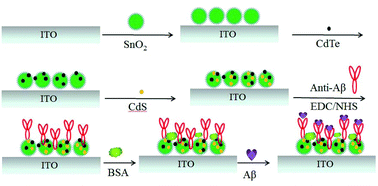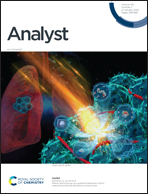A photoelectrochemical immunosensor based on CdS/CdTe-cosensitized SnO2 as a platform for the ultrasensitive detection of amyloid β-protein†
Abstract
An ultrasensitive label-free photoelectrochemical (PEC) immunosensor was developed to detect amyloid β-protein (Aβ) based on CdS/CdTe-cosensitized SnO2 nanoflowers. Specifically, SnO2 with a flower-like porous nanostructure was utilized as a perfect substrate for the construction of PEC immunosensors, and the SnO2-modified electrode was first coated with CdTe quantum dots (QDs) and then further deposited with CdS by successive ionic layer adsorption and reaction techniques. The formed SnO2/CdS/CdTe-cosensitized structure exhibited excellent photocurrent intensity and was employed as an excellent photoactive matrix to immobilize Aβ antibody to further construct the immunosensor. Under optimal conditions, the as-constructed PEC immunosensor was used to detect Aβ and exhibited a wide linear concentration range from 0.5 pg mL−1 to 10 ng mL−1, with a low limit of detection (LOD, 0.18 pg mL−1, S/N = 3). Meanwhile, it also presented good reproducibility, specificity, and stability and may open a new promising platform for the clinical detection of Aβ or other biomarkers.



 Please wait while we load your content...
Please wait while we load your content...